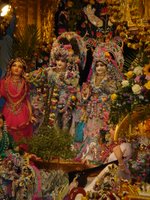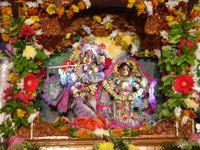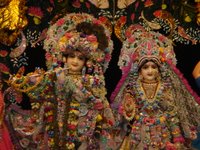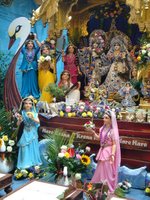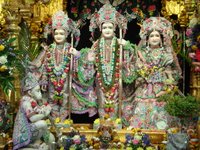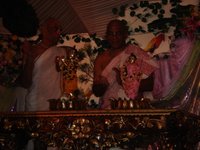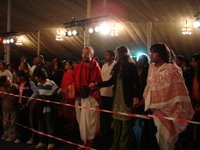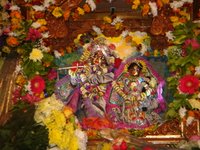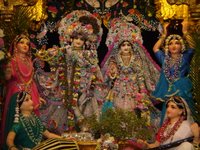Adhikarana I - The form of the Souls in Mukti.
In this chapter is determined the enjoyment of lordliness and the rest which the freed souls experience, as well as the nature of such souls. In the Chandogya Upanishad is heard the following (8.12.3):-
evam evaiSa samprasAdo'smAc charIrAt samutthAya paraM jyotir upasampadya svena rUpeNAbhiniSpadyate, sa uttamaH puruSaH, sa tatra paryeti, jakSat krIDan ramamANaH strIbhir vA yAnair vA jJAtibhir vA nopajanaM smarann idaM zarIram: sa yathA prayogya AcaraNe yuktaH, evam evAyam asmin zarIre prANo yuktaH
"He through whose grace this released soul, arising from his last body, and having approached the Highest Light, is restored to his own form is the Highest Person. The Mukta moves about there laughing, playing, and rejoicing, with women, carriages, with other Muktas of his own period or of the past Kalpas. (So great is his ecstasy) that he does not remember even the person standing near him, nor even his own body. And as a charioteer is appointed by his master to drive the carriage, just so is the Prana appointed to drive this chariot of the body."
Doubt: Here arises the doubt - does the soul, in getting Mukti, get a shape and body which is a result accomplished, and which is to be brought about then as, for example, the body of a Deva; or is it only manifesting its own natural character? In other words, what is the meaning of the phrase "svena rUpeNa abhiniSpadyate", "appears in his true form"? Does this "appearance in true form" mean getting a new body, like that of the messengers of Vishnu, or manifesting its own nature?
Purvapaksa: The opponent maintains the view that the soul assumes a new body, to be brought about by then. Because the meaning of the word 'abhiniSpatti' is
accomplishment, so the body is one which the soul accomplishes or makes. If it were otherwise, the the above word would have no meaning at all; and the scriptural texts relating to release would declare what was of no advantage to man. If the word "abhiniSpatti" meant "manifestation of one's own natural charater," then since this natural character already exists in man, it cannot be said to be something
accomplished, and it can be of no advantage to man. Therefore, the phrase "manifests itself in its own form" means that he assumes a
new body, to be brought about then.
Siddhanta: This view is set aside in the next sUtra.
sampad-AvirbhAvaH svena-zabdAt
1. The phrase 'accomplishing one's own form,' means
manifestation in one's real form, because the word Svena,
"in its own," indicates that. - 538
COMMENTARY
When the soul approaches the Highest Light, through the force of its devotion, accompanied by knowledge and dispassion, then there is release for it from the chain of Karma,
and there is manifestation in it of the eight-fold superior qualities, which from latency come into manifestation then. It is then said that there has taken place the manifestation of its natural character. This particular condition, characterised by the rise of one's natural condition to the surface is called
svarUpa abhiniSpatti. Why? Because the word Svena in the above text requires this explanation. This word is an adjective qualifying the word
rUpa in the above. If the soul assumed a ne wbody, then this word would have no force. Because, even without that, it would be clear that the new body
belonged to the soul. The other meaning of Svena would be "belonging to it" and
rUpena would mean "in a form belonging to it." This would be purely a useless expression, for the body, which the soul takes, must
ipso facto belong to it. Moreover the word
niSpatti does not always mean accomplishment, but manifestation also. As in the phrase "
idam ekam suniSpannam."
To the objection that the soul's own true nature is something eternally accomplished, and hence the manifestation of that nature cannot be the soul of man (
puruSArtha) we reply; true, it is the eternal nature of the soul that manifests in Mukti. And yet such manifestation cannot be said to be useless, because the very object and end of all human exertion is to bring about this manifestation. Consequently all such efforts are not useless because they subserve the purpose of bringing about this manifestation. The School of Patanjali holds the view that the mere cessation of pain which arises through the super-imposition of
prakRiti, constitutes the well-being of the soul which has approached the Highest Light, and that
niSpatti is nothing more than this condition of the Self-luminous, pure intelligence. This however is not the VedAnta view. The "release" of the VedAnta is not a state of negation, not a state in which there is merely an absence of all sufferings caused by
prakRiti, but it is a positive state of enjoyment of bliss, as we find in the Taittiriya Upanishad (2.7),
"For having tasted a flavour of the Supreme, he experiences bliss." This shows that in the state of Mukti there is experiencing of intense bliss and not merely a cessation of pain.
But, how do we know that approaching the Highest Light is Mukti? To this question the next
sUtra gives a reply.
Note - To understand the argument fully it is necessary to know the context of the whole passage of the Chandogya Upanishad in which the above text of "approaching the Highest Light" occurs. One must read the whole of the history of the teaching given by Prajapati to Indra and Virochana as we find in the Chandogya Upanishad (8.7-12). It is in those Khandas from 7-12 that Prajapati teaches the nature of the soul in the waking state as well as in the dreaming and dreamless sleep. When, however, Indra is not satisfied with these partial truths, Prajapati finally promises "I shall explain him further to you, and
nothing more than this." In fulfilment of this promise, he teaches the condition of the soul in Mukti.
References:Taittiriya Upanishad 2.7:
asad vA idam agra AsIt, tato vai sad ajAyata, tad AtmAnaM svayam akuruta, tasmAt tat sukRtam ucyate.
yad vai tat sukRtam, raso vai saH, rasAm hy evAyaM labdhvAnandI bhavati, ko hy evAnyat kaH prANyAt, yad eSa AkAza Anando na syAt, eSa hy evAnandayAti, yathA hy evaiSa etasmin nadRzye'nAtmye'nirukte'nilayane'bhayaM pratiSThaM vindate, atha so'bhayaM gato bhavati, yadA hy evaiSa etasminn udaram antaraM kurute, atha tasya bhayam bhavati, tattveva bhayaM viduSo'manvAnasya.
"Non-existent, verily, was this (world) in the beginning, Therefrom, verily was existence produced. That made itself a soul. Therefore is it called the well-made.
"Verily, what that well-made is - that, verily, is the essence of existence. For, truly, on getting the essence, one becomes blissful. For who, indeed, could live, who breathe, if there were not this bliss in space? This, verily is it that bestows bliss. For truly, when one finds fearlessness as support in Him who is invisible, bodiless, undefined, without support, then has he reached fearlessness. When, however, this (soul) makes in this One the smallest interval, the, for him, there is fear. That, verily, is the fear of the knower, who does not reflect. As to that, there is also this verse." (S. Radhakrishnan)
Chandogya Upanishad 8.12.3 Alternative translation:
"Even so that serene one when he rises up from this body and reaches the highest light appears in his own form. Such a person is the Supreme Person. There such a one moves about, laughing, playinmg, rejoicing with women, chariots or relations, not remembering the appendages of this body. As an animal is attached to a cart so is life attached to this body." (S. Radhakrishnan)

